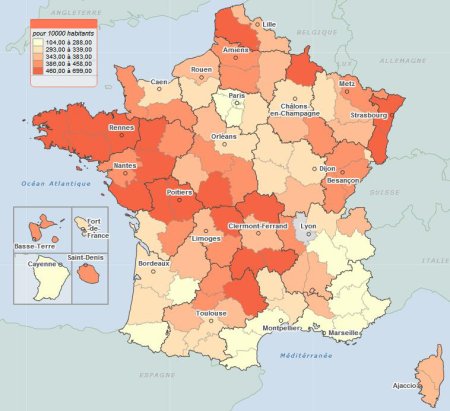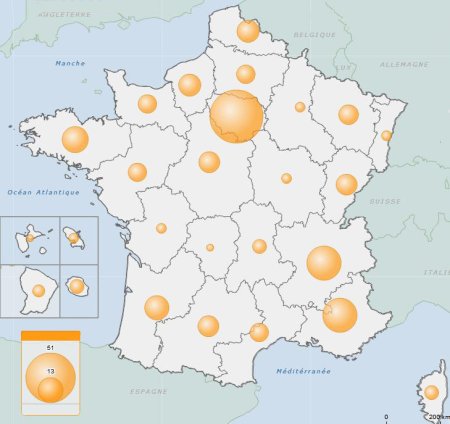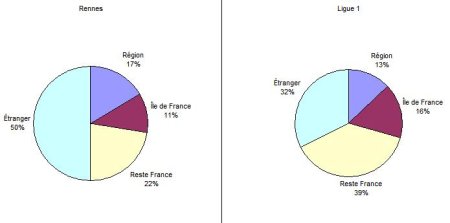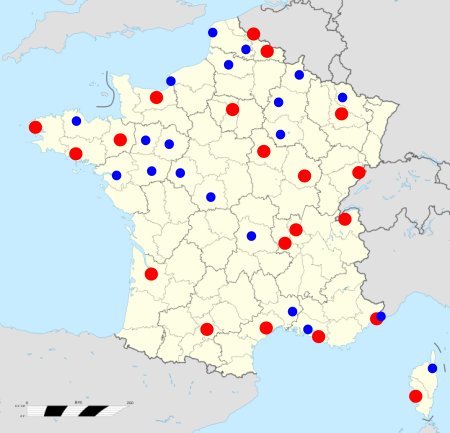Is Stade Rennes a regional team?
Publié le 31 December 2011 à 18h02 byStatistics. Often criticised for failing to give a place to local players, is Stade Rennes that far from its regional setting? With three Breton players and a lot of foreigners in its squad, is Rennes more distant to its base than other Ligue 1 clubs? Not so simple…
The perspective of seeing a starting XI composed nearly exclusively of Breton players is a recurring theme at the Stade Rennais. Many of the club’s leaders have expressed this wish, including Louis Girard in 1955, Joseph Dault in 1973, or François Pinault when he took over the club in 1998. To this day, with three players born in Brittany in its starting eleven (Danzé, Féret, Théophile-Catherine), Stade Rennes is still far from this situation.
However, before drawing any conclusions on this fact, several factors deserve to be carefully observed. Regarding the current level of Breton football in the first place, but also in comparison with other clubs in the top flight, Bretons or not. This is what this statistical study will try to assess. In that goal, all players having regularly appeared in Ligue 1 since the beginning of the 2011-2012 season have been considered, as well as their place of birth [1] [2], in the aim to complete a good overview of Ligue 1.
Brittany, a region of football

Without a doubt, Brittany is one of the liveliest regions of France when it comes to football. Fourth region in the country in terms of the number of licences delivered, it is – in proportion – one of the regions were football is most practised [3]. In fact, Brittany is home to a very important of professional clubs, while only two professional clubs sharing the whole of the South-West regions, Bordeaux and Toulouse.
Considering this presence, and the force of the Breton cultural identity, expectations are logically important, notably in term of the presence of players from the area in the local teams. But in fact, are there that many players of Ligue 1 born in Brittany?
Generally, Brittany is managing a good score in that area. Less populated than Nord-Pas-de-Calais, Aquitaine or Pays de la Loire, it has more players in the top flight than those three regions. Brittany remains far from Provence, Rhône-Alpes and Île-de-France however. A very logical situation since those regions are much more populated, and therefore constitute a much more important “potential”, despite a lesser proportion of licensed players within the population.
However, it seems to be much easier to become a Ligue 1 footballer when one is born in Île-de-France than in Brittany. In the greater Paris, there is indeed one Ligue 1 players for 4,400 licensed players, against one Ligue 1 players for 11,500 in Brittany. A ratio of nearly three to one between the two regions. Difficult to do any interpretation on this figure however, which is probably dependent on many factors (academy structures, density of the scouting networks, etc.)?

In total, there are fourteen players born in Brittany within Ligue 1’s squad [4]. Surprisingly, half of them were born in Morbihan and only one in Ille-et-Vilaine. A meagre total for a department with so many players, but which could change in the future, looking at the number of young players from Rennes, Saint-Malo and Vitré currently in the ranks of SRFC’s Academy.
Among these fourteen players, only six have never played for Stade Rennais. Seven of the other eight were actually trained at the club, Arnaud Le Lan being the only exception. Matthias Autret was trained in Brest, Jérémy Morel and Le Lan in Lorient, Joris Marveaux and Frédéric Sammaritano in Nantes, and Anthony Le Tallec in Le Havre, while Larsen Touré – the son of a former professional footballer for Brest, grew up in the north of France without joining an Academy. Stade Rennais has therefore trained half of the Breton players in Ligue 1. Difficult in those conditions to accuse them of neglecting the regional aspect in their Academy policy, when the club has nearly always spotted the best players in the region over the last few years.
Proportion of regional players: Rennes in the leading positions
In order to define the space left to regional players within a squad, several criteria are being used.
- The total number of players;
- The number of games played by those, considering that a key player has obviously got more importance than a youngster trying to earn his place in the rotation;
- The number of regional players trained at the club, often signifying a stronger bound to the club, especially when several clubs are sharing the influence on a same region.
With three players born in Brittany, trained at the club and regularly in the starting eleven, Stade Rennes is finding its place at the top of Ligue 1.
In terms of numbers, no Ligue 1 club has got more than four regional players and, in total, only one club is truly beating Stade Rennes in this domain: Bordeaux. The Girondins have got four players from the Aquitaine region in their squad, three of them born in the greater Bordeaux area (Chalmé, Planus and Trémoulinas), with Lamine Sané (born in Dordogne) the same exception. All these players were trained at the club and are regular starters this season, except for Chalmé. A noticeable performance considering the number of players from Aquitaine in the Championnat (12), but to be relativized because of the absence of a real regional competition for Bordeaux.
Four more teams have got four regional players in their squad, but all of them must be considered with a few reserves. In the Rhône-Alpes region, Lyon and Saint-Étienne are in a similar position: their four regional players are all trained at the club, but they aren’t all regular starters. Both teams are building their future around young players from their respective Academies, but only Gonalons is considered a key player for “Les Gônes” (Lacazette, Pied and Grenier are only utility players), as is Saint Etienne’s Faouzi Ghoulam (Néry, Zouma and Saadi are not first team members yet, either). The high number of players is made easy however by the important of Ligue 1 players born in the Rhône-Alpes (24).
Paris and Marseille also have four regional players in their squads, once again made easier by the number of players born in the Île-de-France (58) and in the Provence region (24). These players, however, are often “returning” players who haven’t been trained at their club. Examples: Fanni, Gignac and Amalfitano in Marseille, as well as Zoumana Camara and Jérémy Ménez in Paris. All are not regular starters either, such as Gignac in Marseille and Bahebeck in the capital.
From these examples, one could notice that the number of regional players in a squad is also depending on the number of regional players available. On this aspect, Ajaccio honours Corsica by gathering three of the four Ligue 1 players born on the “Isle of Beauty” (Montpellier’s Cabella is the only exception). Bordeaux, Sochaux and Toulouse also managed to attract a third of the Ligue 1 players born in their respective areas, profiting of the fact competition doesn’t exist in their administrative region.
Among the clubs whose squads are failing to give a substantial place to local players, the French Champions, Lille, are in good position with only one player from the Nord region (Debuchy) among the ten playing in Ligue 1, equal to their neighbour Valenciennes (Mater). Nancy, with only one player from Lorraine, who isn’t even a regular starter (youngster Jeannot) is in the same category. Other clubs are showing disappointing levels looking at the potential existing in their region, starting with the PSG, the only professional club in the Paris region. Finally, the two clubs from Bourgogne, Auxerre and Dijon, are the only two without a regional player in their squad. Somehow a normal situation considering only two players born in Bourgogne play in Ligue 1 (Ajaccio’s Mostefa and Paris’ Chantôme), but surprising in relation to AJA’s reputation as an Academy club.
Except for Bordeaux, and considering the competition of the other two Breton clubs, Stade Rennes is at least equal to all other clubs in terms of regional positioning of its squad. Indeed, by using the three criteria described above, only FC Sochaux does as well (with Sauget, Nogueira et Butin), with less regional players available (nine in Franche-Comté against 14 in Brittany) but no competition whatsoever on their regional territory.
I comparison to the other Breton clubs, Rennes is far better. Lorient has only got two Bretons player in its squad (Autret and Le Lan), has only trained the latter and none of them is a regular starter. Meanwhile, Brest only has one player born in Brittany (Larsen Touré), who isn’t a regular starter and wasn’t trained at the club. The club from Finistère also includes Yoann Bigné in its squad, but he doesn’t play with the professional squad anymore. However, and if the development of the Academies continues in this clubs (read previously), they should be catching up little by a little, even though they are still quite far behind.
A “foreign” recruitment
Although Stade Rennes is therefore not really (or even not at all) less of a “regional” club than the others clubs in Ligue 1, it keeps the image of a club without a strong attachment to its territory. To understand this, the general composition of the squad must be analysed rather than the regional aspect.
Often pointed at, the number of players born in the Greater Paris isn’t especially important in Rennes. Only Mavinga and Pajot are bringing this number up to 11% of the squad, under the average of Ligue 1 clubs (16%). On this ranking, the clubs with the most Parisian players are Bordeaux and Dijon (26% each) before Nancy (25%), Brest (23.5%) and Lorient (22%). On this aspect, the latter two clubs are giving more space to Parisian players than Stade Rennes.
The difference at Stade Rennes is in the number of players born abroad and composing its squad. Among the players having featured in five or more games in the league since August 2011, they account for half of the squad, a record in Ligue 1 this season. Auxerre, Lille and Nice (47%) are following closely behind, but Stade Rennais remains far above the national average (There are 116 players born abroad out of a total of 358 in the top flight, a total of 32.4%).
A very high figure caused by the choices of recruitment more than by those of training since, among those players, only Jirès Kembo was trained at the club. It can also be noted that only four of the nine players born abroad who compose the Rennes squad were recruited outside France (Boye, Mandjeck, Tettey and Pitroipa), the other coming from other Ligue 1 clubs (Boukari, Hadji, Mangane and Montaño).

Considering this, would there be any reason to hit at this strategy, knowing that – as shown previously – Stade Rennes honours its region as much (if not more) than other Ligue 1 teams, in an era where the Nosman rule has largely globalised the professional teams ? And although Jean Grumellon, Raymond Keruzoré, Jean Prouff or Pierrick Hiard have carried the Breton colours at the highest levels, how could one forget the likes of Laurent Pokou, Walter Kaiser, Silvester Takač or more recently Shabani Nonda, Alexander Frei or Petr Čech, who largely contributed in delighting the Rennes supporters?
Since the 1920s, Stade Rennes built itself by integrating foreign players, many of them proving to be very valuable elements for its success. Pursued by its successive managements, looking like some sort of demagogic routine, the objective of a team composed nearly only with Breton players was never fulfilled over the long term, except maybe in the 1950s, when the Rouge et Noir were the only professional team in Brittany and Nantes had not yet known the D1 level. A chimeric objective which is likely to remain a dream for many more years, probably for the best.
